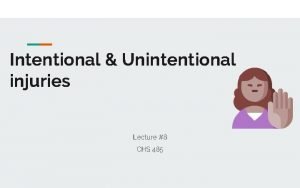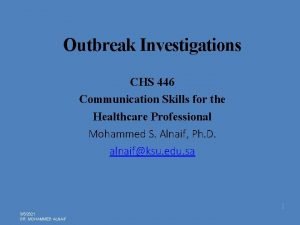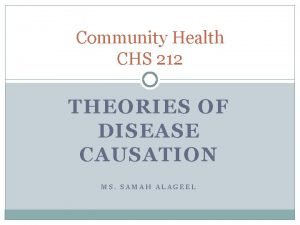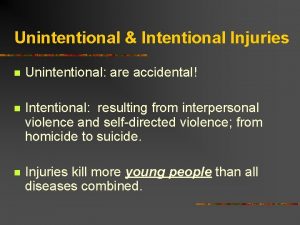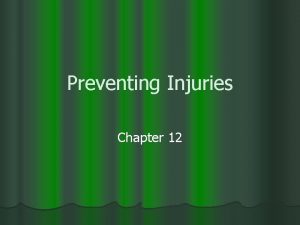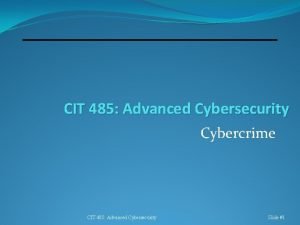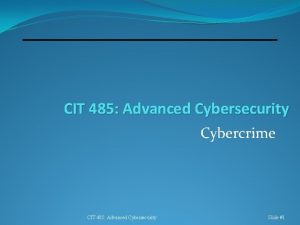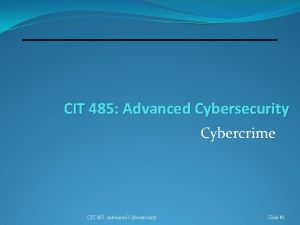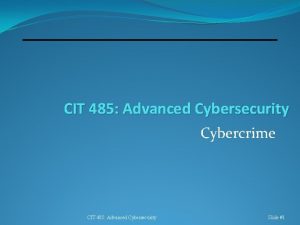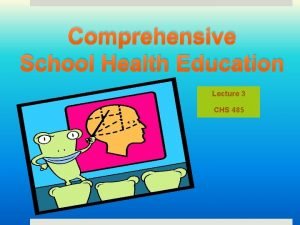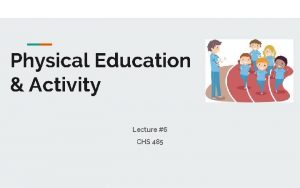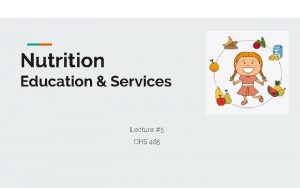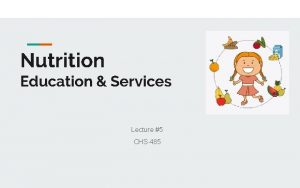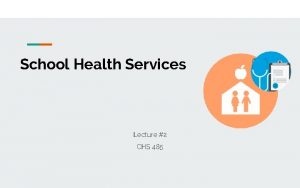Intentional Unintentional injuries Lecture 8 CHS 485 Intentional




















- Slides: 20

Intentional & Unintentional injuries Lecture #8 CHS 485

Intentional / Unintentional injuries - An injury is defined as "unintentional or intentional damage to the body resulting from acute exposure to thermal, mechanical, electrical, or chemical energy or from the absence of such essentials as heat or oxygen". Injuries can be further classified based on the events and behaviors that precede them as well as the intent of the persons involved.

- Schools have a responsibility to prevent injuries from occurring on school property and at school-sponsored events. - In addition, schools can teach students the skills needed to promote safety and prevent unintentional injuries, violence, and suicide while at home, at work, at play, in the community, and throughout their lives. (CDC)

Unintentional injuries— such as those caused by burns, drowning, falls, poisoning and road traffic accidents— are the leading cause of morbidity and mortality among children in the United States. Each year, among those 0 to 19 years of age, more than 12, 000 people die from unintentional injuries and more than 9. 2 million are treated in emergency departments for nonfatal injuries.

Students with higher grades are significantly less likely to have engaged in behaviors such as: • Riding with a driver who had been drinking alcohol • Carrying a weapon • Being in a physical fight • Feeling sad or hopeless • Attempting suicide

What is Youth Violence? Youth violence is the intentional use of physical force or power to threaten or harm others by young people ages 10 -24. It typically involves young people hurting other peers who are unrelated to them and who they may or may not know well. Youth violence can take different forms. Examples include fights, bullying, threats with weapons, and gang-related violence. A young person can be involved with youth violence as a victim, offender, or witness.

How big is the problem?

- Victims of violence are more likely to experience a range of problems not reflected in these estimates, including depression, post – traumatic stress disorder, cardiovascular disease and diabetes. - The combined direct and indirect costs associated with violence include: 1. expense related to medical care 2. decreased property values disrupted social services 3. lost productive 4. reduced quality of life.

Protective Factors for the Perpetration of Youth Violence: Risk Factors for the Perpetration of Youth Violence: A combination of individual, relationship, community, and societal factors contribute to the risk of youth violence. Risk factors are characteristics associated with youth violence, but they are not direct causes of youth violence. Protective factors buffer young people from the risks of becoming violent. To date, protective factors have not been studied as extensively or rigorously as risk factors. Identifying and understanding protective factors are equally as important as researching risk factors. ● ● ● ● High IQ/ high academic achievement High educational aspirations Positive social orientation Popularity acknowledged by peers Highly developed social skills/competencies Highly developed skills for realistic planning Religious beliefs

School violence is a subset of youth violence. Acts of violence can disrupt the learning process and have a negative effect on students, the school itself, and the broader community. Examples of violent behavior include: ● ● ● Bullying Fighting (e. g. , punching, slapping, kicking) Weapon use Cyberbullying Gang violence Where school violence occurs: ● ● ● On school property On the way to or from school During a school-sponsored event

According - to CDC’s Youth Risk Behavior Survey (YRBS): Nearly 24% of students had been in a physical fight on school property one or more times during the 12 months before the survey. - Nationwide, about 7% of students had not gone to school at least 1 day during the 30 days before the survey because they felt they would be unsafe at school or on their way to or from school.

Bullying is a type of youth violence that can result in physical injuries, social and emotional problems, and academic problems. The harmful effects of bullying are frequently felt by friends and families and can hurt the overall health and safety of schools, neighborhoods, and society.

Guidelines for schools to prevent Unintentional Injuries & Violence in Schools - All students have the right to learn in a safe and protective school environment. Preventing unintentional injuries, violence, and suicide in schools would help improve the learning environment. - Schools can teach students the skills needed to promote safety and reduce their risk for unintentional injuries, violence, and suicide throughout their lives.

Key principles for prevention programs Unintentional injury, violence, and suicide prevention programs for young people are most likely to be effective when they: Become a national priority and are reinforced by community-wide efforts in which school and community leaders, as well as families commit to implementing and sustaining unintentional injury, violence, and suicide prevention.

Topics: Anger management. Bullying. Dating violence. Gun safety. Personal safety (dealing with stranger). Pre-social behaviors. Recognizing signs and symptoms of people who are in danger of hurting themselves. ● Sexual assaults and rape. ● ● ● ● Essential Skills: *Techniques to conflicts and fights. avoid *What to do if someone is thinking about hurting him/herself. *What to do if someone is thinking about hurting others.

School health recommendations for preventing unintentional injury, violence, and suicide among young persons. The guidelines include recommendations related to the following eight aspects of school health efforts to prevent unintentional injury, violence, and suicide: 1. A social environment that promotes safety 2. A safe physical environment 3. Health education curricula and instruction 4. Safe physical education, sports, and recreational activities 5. Health counseling, psychological, and social services for students 6. Appropriate crisis and Emergency Response 7. Involvement of families and communities 8. Staff development to promote safety and prevent unintentional injuries, violence, & suicide.

Key principles for prevention programs

https: //youtu. be/Yy. DJafzu. UK 4

Extra Shots Suggested Readings - References Intentional & Unintentional Injuries Guidelines for School Health Programs to Prevent. . . - CDC. . . https: //stacks. cdc. gov/view/cdc/21064/cdc_21064_DS 1. pdf • Telljohann, Susan Kay, Cynthia Wolford Symons, and Beth Pateman. (2001) Health education: Elementary and middle school applications. New York: Mc. Graw-Hill. Chapter 2 and 3. • The Centre of Disease Control (CDC) • Journal of School Health. * https: //www. cdc. gov/violenceprevention/pdf/yvfactsheet 508. pdf

Life is 10% what happens to you and 90% how you react to it. . . _ Charles R. Swindoll Best!
 Battering intentional or unintentional
Battering intentional or unintentional Intentional injury
Intentional injury Example of intentional fallacy
Example of intentional fallacy Ig5a 485 통신 예제
Ig5a 485 통신 예제 Ley 26 485
Ley 26 485 Unintentional threats to information systems
Unintentional threats to information systems Example of unintentional tort
Example of unintentional tort Sample pes statements
Sample pes statements Chs module
Chs module J'chs 2
J'chs 2 Chs statistics
Chs statistics Budowa dysku twardego
Budowa dysku twardego Baseball parent meeting agenda
Baseball parent meeting agenda Chs investigations
Chs investigations St. robert catholic high school ib registration
St. robert catholic high school ib registration Chs investigations
Chs investigations Chs scaffolding
Chs scaffolding Chs.edf.school
Chs.edf.school Example of chs theories
Example of chs theories Chs vs ibs
Chs vs ibs Maryland integrated science assessment
Maryland integrated science assessment

